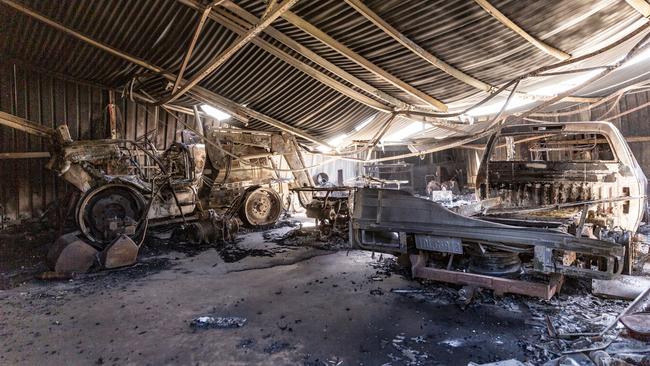Counting the cost of cataclysmic WA fire storm
In the middle of a wide swath of the fire-affected zone in Gidgeganup, fierce gusts still whip ash into the air along Dinsdale Road.

In the middle of a wide swath of the fire-affected zone in Gidgeganup, the epicentre of one of the most destructive bushfires in Western Australian history, fierce gusts still whip ash into the air along Dinsdale Road.
Avenues of blackened trees and broken power lines mark where dozens of firefighters and tens of thousands of litres of fire retardant stopped the Wooroloo front overnight … but not before the flames licked under the wooden veranda eaves. Within minutes, roofs collapsed and gutters and pipes melted into the ground. Many residents are still awaiting permission to go back to see what is left.
Within 3km of the fire’s source, believed to be Werribee Road in Wooroloo, rural hobby farms lie empty and damaged beyond recognition — a stable, stock yards, even rabbit hutches reduced to the same blackened frames as a family homestead.
The smell of smoke is still strong as it mingles with the acrid odour of plastic water tanks that melted into the ground.
White fences at a horse stud lie in mangled wrecks on black paddocks. More than 300 horses have been rehoused in a single Perth racing stud, as a team of volunteer vets on Thursday ventured into burnt-out properties to rescue stock.
A pair of garden chairs face each other in an ash wilderness. A few metres away, a burnt tractor sits in a dilapidated shed.
The dangers of entering a fire-scorched landscape are everywhere — dangling powerlines on treetops, large eucalypts with smouldering fires at their base.
Fire crews say it could take weeks to topple burnt trunks and repair power poles.
Fences can be restored and houses rebuilt, but residents like Gillian Catlow and her husband, Charley Hoernemann, will walk away. The two musicians moved to Gidgeganup three months ago in an impulsive move from city to country life. They lost her dozen violins, his 24 guitars and a 100-year-old Steinway that had belonged to Ms Catlow’s mother. They’re insured, but they won’t be back. “We’re not tough, we’re city slickers at heart, so we won’t be rebuilding,” Ms Catlow said.
Their neighbour, a woman who stayed with her three kids, watched the flames destroy Ms Catlow’s house and sent her the devastating photos of the wreckage. Only the potbelly remains.
“We feel like our hearts have grown from all the help that’s flooded in,” Ms Catlow said.
Other residents of the Perth hills are pondering a bigger question. Many have got cleared firebreaks and made a fireplan. But in a part of the state that has suffered more than 20 per cent less rainfall and hotter summers, what chance of another cataclysmic fire storm in summers to come?
Fire commissioner Darren Klemm said nature posed the more immediate problem at Shady Hills on the northwest edge of the fire zone, which was saved overnight after firefighters resorted to handheld shovels and rakes to clear the breaks.
The tally of misery has gone up: 81 houses have been destroyed in the worst fire on record in Perth’s outer metro area.



To join the conversation, please log in. Don't have an account? Register
Join the conversation, you are commenting as Logout